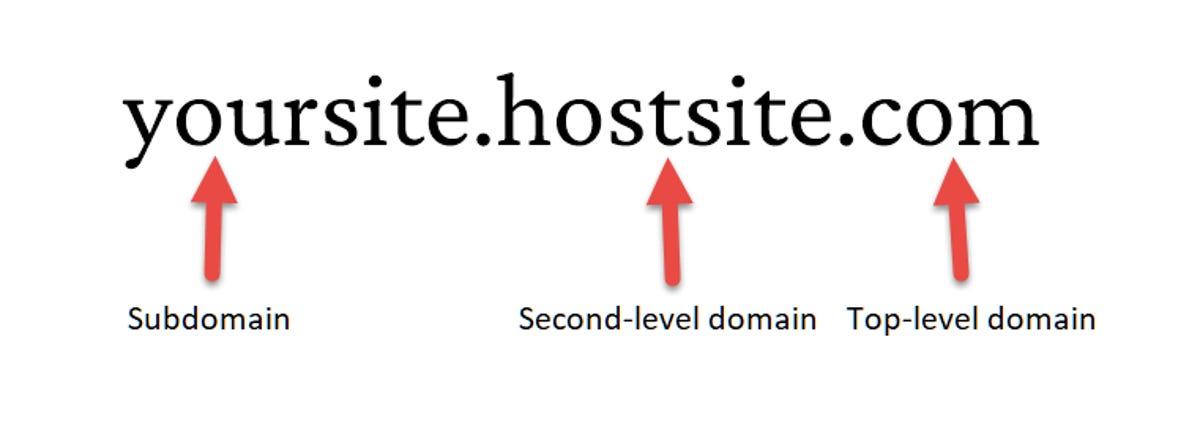What is web hosting, what is a domain, and how are they different? You’ll need both web hosting and a domain to publish a website. Web hosting is the space your website occupies, and a domain is the address used to find that space.
There’s a lot more to understand about web hosting and domains if you want to publish a website. Let’s explore web hosting and domains so you can understand the differences — and how they connect.
What is web hosting?

A person working in a server room
Websites are hosted on specialized web servers, which are computers configured to run 24/7 that make your website files accessible to web browsers. The process of placing and storing website files on these servers is called web hosting.
A web hosting company builds these servers and rents space on them to people and businesses to use for creating websites. Using a web host is the ideal way to make a website, as creating your own web server is expensive and labor-intensive.
Good web hosting companies also provide:
- Security through programs like firewalls installed on their servers.
- Tools that speed up your site, like caching and content delivery networks, or CDNs.
- Technical support you can access 24/7 via phone, email or live chat if something goes wrong with your website.
They may also provide extras like email hosting so you can create email addresses at your domain.
Types of web hosting
The most popular types of web hosting are:
- Shared hosting, which stores several websites on a single server. This is the most affordable type of web hosting, but it isn’t suitable for high-traffic websites because sites share server resources — if traffic for one site spikes, others may experience slowdowns.
- WordPress hosting, where the company pre-installs WordPress and updates the CMS for you. This is often shared hosting with a slightly higher price because of the additional maintenance provided. Some companies offer WordPress-optimized VPS or cloud hosting.
- Website builder hosting, which features a pre-installed website builder. This simplifies website creation, as you don’t need to install anything like you do with WordPress. These plans are typically shared hosting or, if purchased from a company like Squarespace, cloud hosting.
- Cloud hosting, which stores your website on several servers located in different data centers. This ensures faster loading speeds and minimizes downtime. This tends to be more expensive than shared hosting.
- VPS hosting, or virtual private server hosting, which separates one physical server into several virtual servers with dedicated resources for handling significant traffic volumes.
- Dedicated hosting, which gives your business a full physical server, maximizing your resources. This is quite expensive and sometimes requires extensive setup on your end.
The cost of web hosting varies significantly depending on the type of web hosting you choose and the company you’re working with, but as a general rule, shared hosting starts at $1 to $5 per month. Every other type costs more — sometimes even thousands of dollars a month.
You can learn more about these types of web hosting, and how to choose the right one, in our guide to hosting a website.
What is a domain?

Core parts of a domain
A domain is the name used to find a website. For example, our domain is CNET.com.
The domain consists of two parts:
- The name or second-level domain. In our example, this is CNET. The most common approach to choosing a domain name is to use your company name. This ensures consistency in branding, which helps you avoid confusion and maximizes audience trust.
- The domain extension or top-level domain — TLD for short. This is the .com in our example. Many TLDs exist to signify the type of company a website belongs to (like .org for nonprofits). Others, like .com, are used by all types of companies or even individuals.
Domains are distributed by the Internet Corporation for Assigned Names and Numbers, or ICANN. You don’t purchase domains directly from ICANN. Instead, you purchase them from domain registrars, which are companies that register domains with ICANN for you.
Domains are typically purchased annually and cost $10 to $50 per year.
Types of domain
The various types of domains are defined by the TLDs they use. Most websites use one of two types of TLDs: country code top-level domains, or ccTLDs, and generic top-level domains, or gTLDs. Some websites, such as government websites, also use sponsored TLDs, like .gov or .edu.
ccTLDs
Country code TLDs consist of international country codes, such as “in”for India. This signifies that a website operates in the country associated with its ccTLD. Many ccTLDs are available only to people or businesses with an address in the appropriate region.
ccTLDs include:
- .ca for Canada.
- .co.uk for the United Kingdom.
- .in for India.
- .se for Sweden.
You should use a ccTLD if you intend to cater to customers in a specific country. If you have an international audience, a gTLD is your best choice.
gTLDs
Generic top-level domains aren’t restricted to a specific country or type of business. Anyone can purchase them and they can be used for any type of website. However, some gTLDs are associated with particular kinds of companies, including:
- .net is associated with internet service providers and other companies dedicated to creating or improving internet infrastructure.
- .org is associated with nonprofits.
- .io and .tech are associated with tech companies.
- .ai is associated with companies that build AI tools.
You can use one of these more specific gTLDs (there are over 1,500 of them) to signify the industry in which you or your company operates.
You can also stick with the generic .com instead. I often recommend the latter option, as .com is easier for visitors to remember. The .com extension is also the most trusted domain extension, according to Growth Badger.
You should use a gTLD if you want to attract an international audience. Companies with international branches may use a gTLD for their main website and ccTLDs for branches in specific countries. For example, Amazon.com is the original site, but there’s also Amazon.ca.
Sponsored TLDs
Sponsored top-level domains are restricted TLDs created by sponsor organizations. To get these TLDs, you must prove that your website belongs to a specific type of organization or company. This helps establish legitimacy and preserve trust in key institutions.
Sponsored TLDs include:
- .edu for post-secondary educational institutions in the US. Other countries have their own equivalents, like .ac.uk for colleges and universities in the UK.
- .gov for government institutions. The standard .gov domain is typically reserved for branches of the US government. Branches of government in other countries can add a country code to signify where they operate, creating a TLD that looks like .gov.uk.
Most websites won’t use a sponsored TLD, but it’s still good to understand what they are.
Subdomains
A subdomain appears before the second-level domain and is used to partition part of a website from the rest. This allows the domain and subdomain to function as separate websites with different information and layouts while maintaining consistent branding.
Subdomains are most often used to partition parts of one company’s website. For example, if your company has an e-commerce store, you might use a subdomain like “store.yourdomain.com” to separate it so you can use a specialized store layout.
The other use for subdomains is to provide free web hosting. In these instances, your site name will be a subdomain of the host site, like this:

Example of what a subdomain looks like
How does a domain work?
Originally, websites were linked only to IP addresses, which are long strings of numbers (like 192.0.2.148) that computers use to identify websites. Humans aren’t great at remembering long numbers, so domains were created to make the internet accessible.
Every domain is connected to an IP address. When you type a domain into your browser, the browser requests its IP address from domain name system, or DNS. When the DNS sends the IP address, your browser connects to it. This allows the browser to load the website.
All of this happens behind the scenes in a matter of seconds to streamline your browsing experience. You won’t be aware of it unless something goes wrong.
How do web hosting and domains work together?
Web hosting services provide space for your website to exist. A domain provides access to that space. If a website were a physical business, web hosting would be the floor space items are placed in and the domain would be the address.
You can design a website on your computer, but nobody will be able to access it outside of your home network unless you configure it properly, which can be challenging.
Similarly, you can buy a domain without web hosting, but it will only display a blank page (possibly with basic information about the web host) until you buy web hosting to place a site on it.
Many companies sell both web hosting and domain registration because of the interconnected nature of these two services. This allows you to manage both your website and your domain in one place. You’ll also only have to process payments to one company.
There are some instances when you might want to buy one service on its own:
- If you want a domain but you’re not ready to build a site. If you want a specific domain, you should register it right away so nobody else does. Web hosting costs more than domain registration, so if you’re not ready to build a site, you can save money by just registering the domain.
- If you previously bought a domain and you’re ready to build the website. Transferring a domain to a new company isn’t practical if you’ve recently paid your renewal fees for registration. You can connect it to your web hosting server instead.
- If you can save money. Some of the best web hosting companies charge more for domain registration than most reputable domain registrars. If you want to use one of these web hosts, you can host your domain through a separate company to save money.
- If you want to flip domains. Some people make money by buying in-demand domains and reselling them at higher prices.
Outside of these specific instances, however, buying your domain and your web hosting package together is the most effective approach.
Web hosting vs. domains: You need both for a fully functioning website
Web hosting and domains are separate but interconnected tools:
- Web hosting gives you space on a server that can be accessed by the internet. This space will be connected to your domain so users can find it.
- A domain is the name of a website. This is connected to your site’s IP address and your website’s nameservers so users can find it without needing the site’s technical details.
You’ll need both to run a website, and you’ll likely buy both from one company to simplify managing your site, domain and finances. However, you can sometimes save money by buying one service at a time, especially if you’re registering a domain before you’re ready to build a website.
A website is a collection of files hosted on a web server so they can be published online. A domain name is the name used to access the website built from those files, such as CNET.com.
Yes, you will need a domain in order to publish your website online. The only exception is if you’re using a free web hosting service that places your site on a subdomain instead of providing a second-level domain. However, you’ll still need a website name to use for that subdomain.
Yes, you can buy a domain name without hosting. This is a good option if you like a specific name, but you’re not ready to build a website or start a business around it yet.
Many web hosting packages include a free domain for the first year. Some include a free domain for following years as well. However, there are also hosting plans that don’t provide a domain at all. Always carefully read the details of any plan you’re considering before you make a purchase.




















+ There are no comments
Add yours